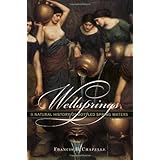
Average Reviews:

(More customer reviews)Are you looking to buy Wellsprings: A Natural History of Bottled Spring Waters? Here is the right place to find the great deals. we can offer discounts of up to 90% on Wellsprings: A Natural History of Bottled Spring Waters. Check out the link below:
>> Click Here to See Compare Prices and Get the Best Offers
Wellsprings: A Natural History of Bottled Spring Waters ReviewThis book reiterates the concerns of the various chemicals used to manufacture plastics, including vinyl chloride, a known carcinagen. Also phthalates are the compound to make finished product more flexible. It has not been verified but the leaching into plastic is toxic and cause more than adverse health effects. The plastic used in bottled water was invented by an engineer hnamed Nathaniel Wyeth.Bottled water started wjithy the use of stonewall bottles which were used to draw water from the shallow wells at the Olympic Games. The materials used to store and package water have always represented the pinnacle of available technology. In 1806, Dr. Stoddard used cathartic (Hawthorne Spring) high-potency to cure rheumatism, gout, dyspepia, liver and kidney difficulties. Another doctor used spring water in Saratoga as a source of iron "to improve the condition of the blood."
Mammoth Cave in Kentucky is part of the largest single system of caverns in the world. Springs develop because of the limestone aquifers of the Appalachian Plateau for drinking water. Near Collinwood in Tennessee Mountains, the springs tap the deeper circulating waters, naturally cleansed and excellent for drinking. It was called Tennessee Mountain Pure. The landscape of eastern Tennessee is dominated by a series of valley and ridges going back 500 million years old. There is a spring at Love Creek from which many locals still get their bottles filled.
By the beginning of the 19th century, the cost of bottle making for the matent medicines (usually mineral water) was not excessive. This confluence of circumstances, which had taken more than 2,500 years since the invention of glass, was the real beginning of the bottled water industry in America.
In 1767, water from a spring in Boston known locally as Jackson's Spa was reportedly bottled for sale. Other water-bottling operations began in a relatively small way in Albany, Philadelphia. It us reported that a Philadelphia druggist was the first person to bottle mineral water in 1825.Wellsprings: A Natural History of Bottled Spring Waters Overview"Many people consider ground water deep beneath their feet as mysterious, perhaps even supernatural. To clarify matters, hydrogeologist Frank Chapelle has written a definitive history and science of subsurface water in his Wellsprings, a book both accessible to the lay reader while being filled with startling nuggets of information pleasing to the professional water scientist."—Donald Siegel, professor of earth sciences, Syracuse University"This book tells the story of bottled water in the United States in a highly readable and in-depth way, covering both the facts of the subject, and the persons and events that resulted in this now ubiquitous product."—Stephen C. Edberg, professor, Yale UniversityBottled water is a part of everyday life for millions of Americans. Per capita consumption in the United States now tops fifteen gallons per year with sales over $5 billion in 2002. Even as fuel prices climb, many people are still willing to pay more for a gallon of bottled water than they are for the equivalent in gasoline. At the same time, bottled water has become a symbol of refined taste and a healthy lifestyle. But despite its growing popularity, many people cannot quite put their finger on just why they prefer bottled water to the much less expensive tap variety. Some have a vague notion that bottled water is "healthier," some prefer the convenience and more consistent taste, and others are simply content to follow the trend. The fact is most people know very little about the natural beverage that they drink and enjoy. It is reasonable to wonder, therefore, just what differentiates bottled water from other water? Is it really better or healthier than tap water?Why is it that different brands seem to have subtle variations in taste? As Francis H. Chapelle reveals in this delightful and informative volume, a complex story of geology, hydrology, and history lies behind every bottle of spring water. The book chronicles the history of the bottled water industry in America from its beginnings in Europe hundreds of years ago to the present day. Subsequent chapters describe the chemical characteristics that make some waters desirable, and provide an overview of the geologic circumstances that produce them. Wellsprings explains how these geologic conditions vary throughout the country, and how this affects the kinds and quality of bottled water that are available. Finally, Chapelle shows how the bottled water industry uses this natural history, together with the perceived health benefits of spring waters, to market their products.Accessibly written and well illustrated, Wellsprings is both a revealing account and a user's guide to natural spring waters. Regardless of your drinking preference, this timely exploration will make your next drink of water refreshingly informed.
Want to learn more information about Wellsprings: A Natural History of Bottled Spring Waters?
>> Click Here to See All Customer Reviews & Ratings Now
0 comments:
Post a Comment